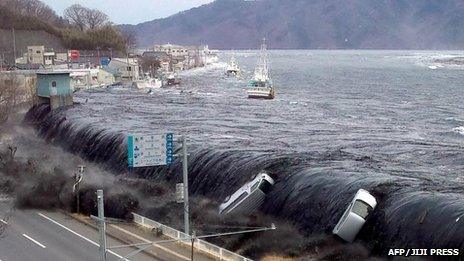GPS data could improve tsunami early warnings
- Published

The researchers say that GPS technology could provide vital extra minutes before a tsunami strikes
Scientists say they have found a way to provide faster and more accurate early warning systems for tsunamis.
A German team says GPS satellite-based positioning could offer detailed information about the events within minutes of an earthquake occurring.
They believe the technology could have improved alerts issued when the devastating tsunami hit Japan in 2011.
The study is published in Natural Hazards and Earth Systems Sciences, external.
When an underwater earthquake happens, with the power to generate a tsunami, every second counts.
The shifting tectonic plates can generate giant walls of water that can travel towards land in minutes, giving little time to put evacuation plans into action.
Precise measurements
Existing early warning systems use seismological data, measuring the waves of energy that are generated as the earth moves and shakes.
But in the vital first stages of an earthquake, this is not always reliable.
Now a team from the GFZ German Research Centre for Geosciences says that satellite navigation technology could help.
GPS sensors placed around the coastlines of vulnerable countries could make highly precise measurements of how underwater tremors shift the ground.
Lead researcher Dr Andreas Hoechner explained: "In case of a subduction earthquake, one plate slips under another plate.
"It is measured in terms of relative displacement. This deformation is mostly above the source, but the coastal area is also deformed and this can be picked up by GPS."
He said that this information could be used to reconstruct the source of the earthquake and calculate its magnitude.
"Then you can then predict the tsunami and see how high a wave could be expected, with some accuracy."
This process would take a matter of minutes, which would allow alerts to be issued extremely quickly.
Disseminate warnings
In the case of the 2011 tsunami that killed 16,000 people in Japan, the technology could have made a significant difference.
Although the Japan Meteorological Agency issued a warning three minutes after the earthquake hit, it underestimated the scale of the event.
It suggested that the quake was 7.9 magnitude; it was actually 30 times more powerful.
By looking at data collected by GPS stations in Japan - which at the time were not used to measure earthquakes - the researchers calculated that this would have provided an accurate estimate of the magnitude within three minutes.
A number of countries are now installing GPS networks, including Chile and the US.
But Dr Hoechner said that as well as having accurate alert systems, well thought-out evacuation plans were also essential.
He said: "One point is to have the technology to realise what the earthquake is and where tsunami will be. But it is at least as important is to disseminate the warning.
"You have to have the infrastructure to transmit this information to the population, and the population has to be ready to know what to do."
- Published25 April 2012
- Published23 March 2012
- Published19 May 2011
- Published14 March 2011